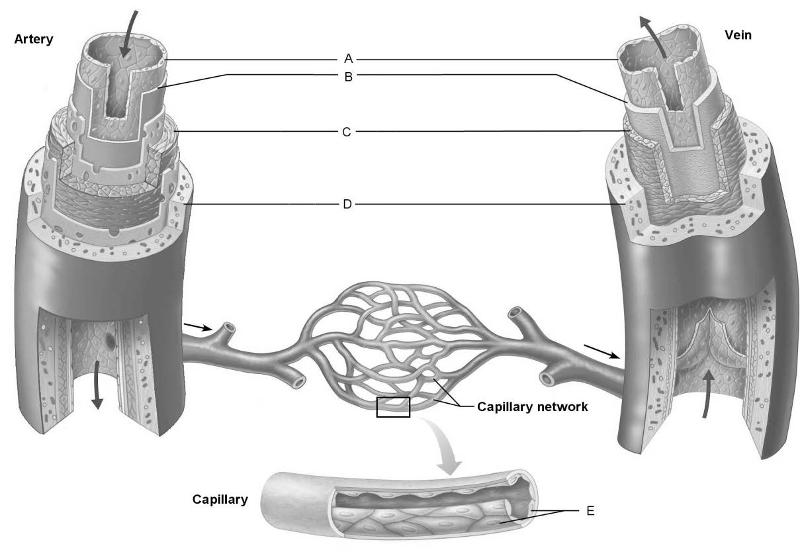
Identify the letter that indicates the layer common to all blood
vessels regardless of their size.
A) A
B) B
C)
C
D) D
E) E
A
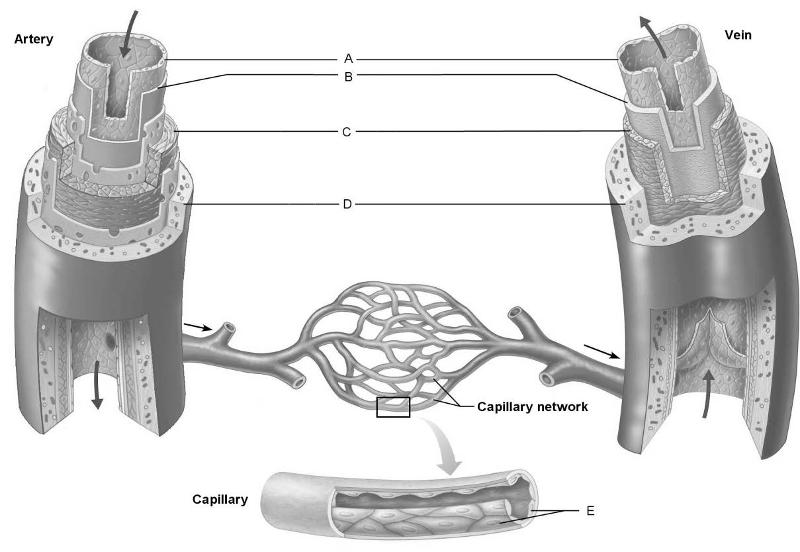
Identify the letter that is indicating endothelial cells.
A)
A
B) B
C) C
D) D
E) E
E
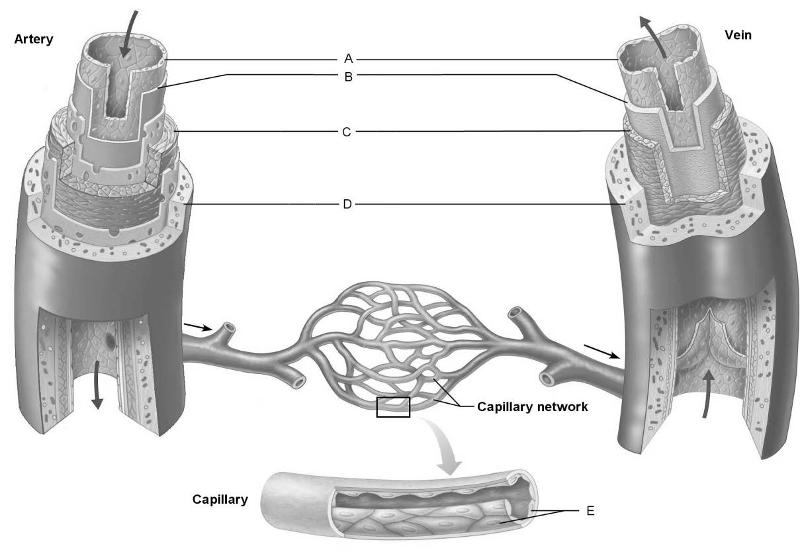
Identify the letter that indicates a connective tissue layer
consisting of longitudinal collagen
fibers.
A) A
B)
B
C) C
D) D
E) E
D
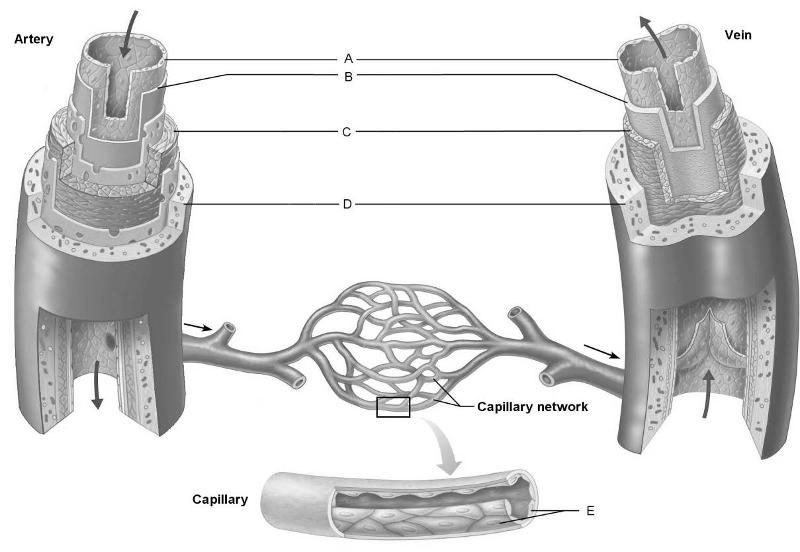
Identify the letter that indicates the blood vessel layer that is
comprised of circular and
longitudinal smooth muscle.
A)
A
B) B
C) C
D) D
E) E
C
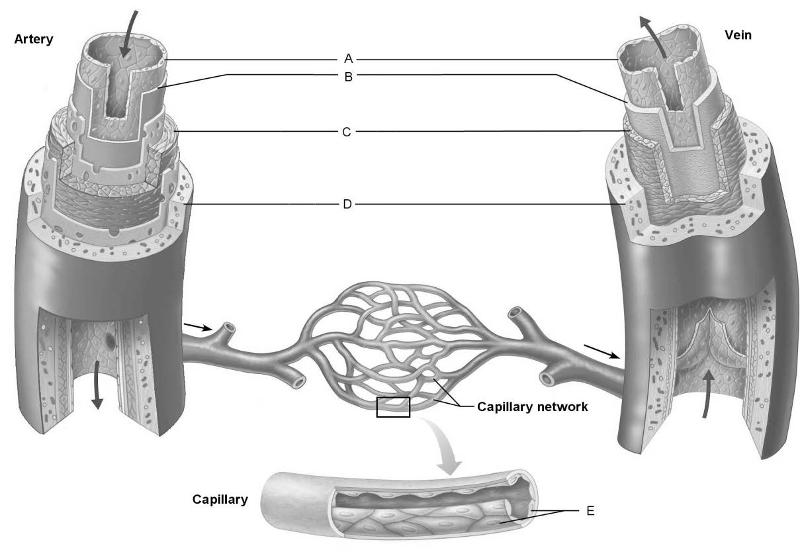
Identify the letter that indicates the subendothelial layer
associated with larger blood vessels.
A) A
B) B
C)
C
D) D
E) E
B
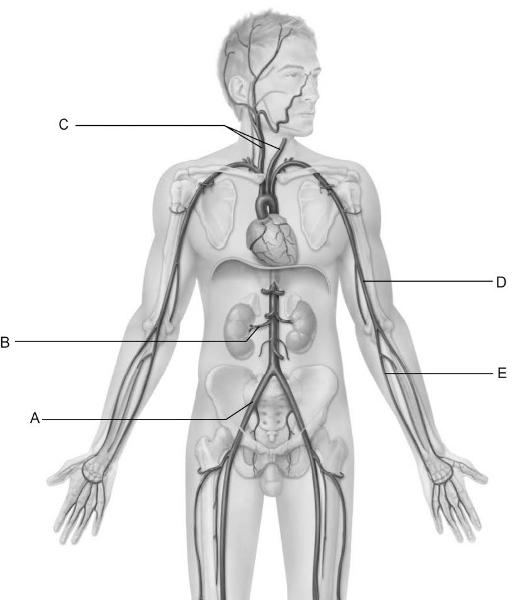
Identify the letter that indicates the common carotid
arteries.
A) A
B) B
C) C
D) D
E) E
C
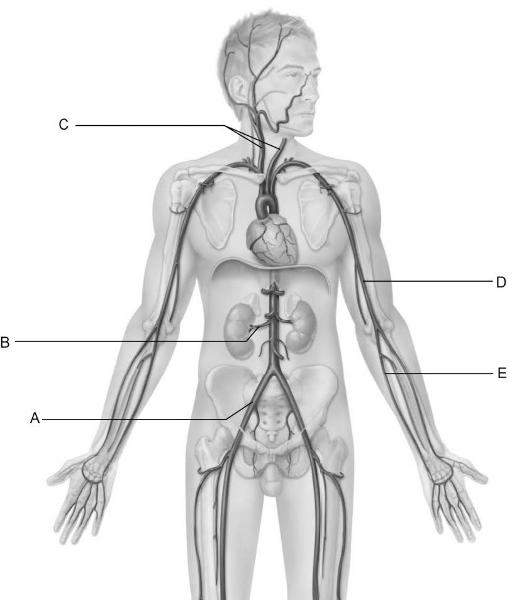
dentify the letter that indicates the common iliac artery.
A)
A
B) B
C) C
D) D
E) E
A
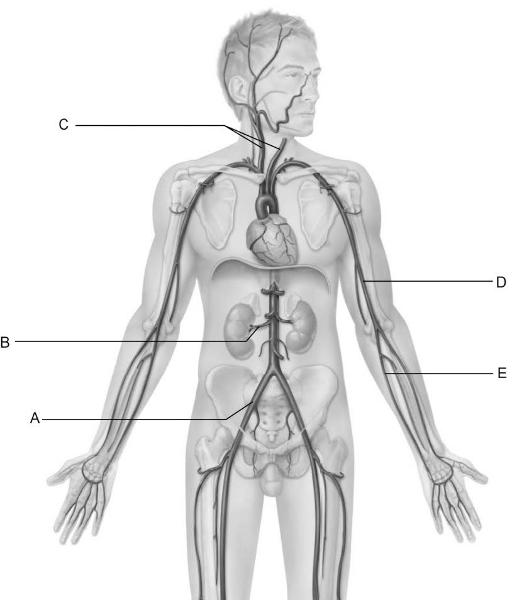
Identify the letter that indicates the brachial artery.
A)
A
B) B
C) C
D) D
E) E
D
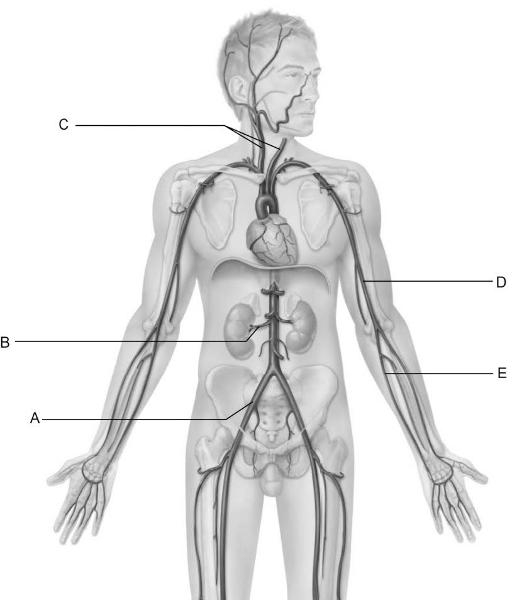
Identify the letter that indicates the renal artery as it branches
from the Abdominal aorta.
A) A
B) B
C) C
D)
D
E) E
B
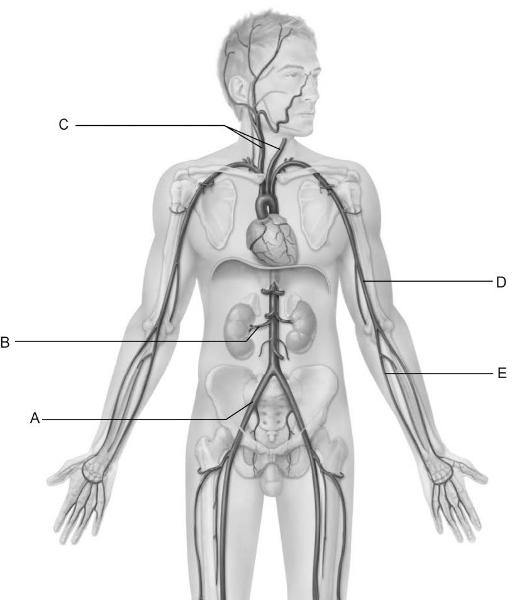
Identify the letter that indicates one of the primary arteries that
contributes to the superficial
palmar arch-the ulnar
artery.
A) A
B) B
C) C
D) D
E) E
E
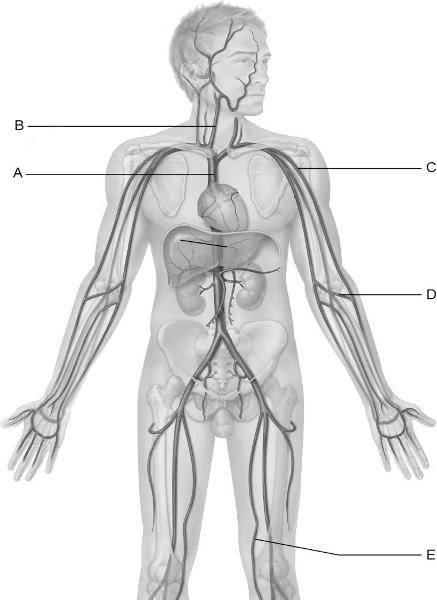
Identify the letter that indicates the vessel that is easy to find in
most people and is used to
obtain blood.
A) A
B)
B
C) C
D) D
E) E
D
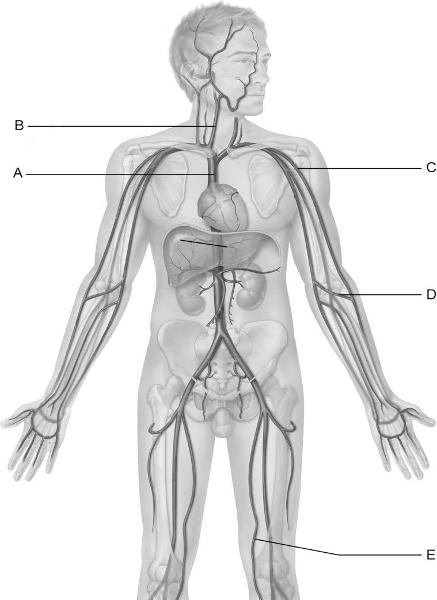
Identify the letter that indicates the longest vein in the
body.
A) A
B) B
C) C
D) D
E) E
E
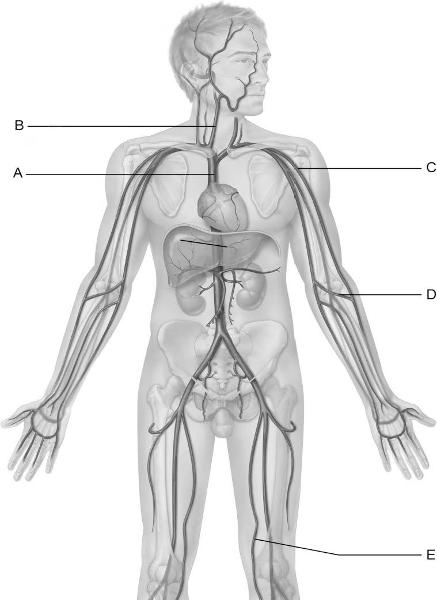
Identify the letter that indicates the vessel that arises from the
union of the left and right
brachiocephalic veins.
A)
A
B) B
C) C
D) D
E) E
A
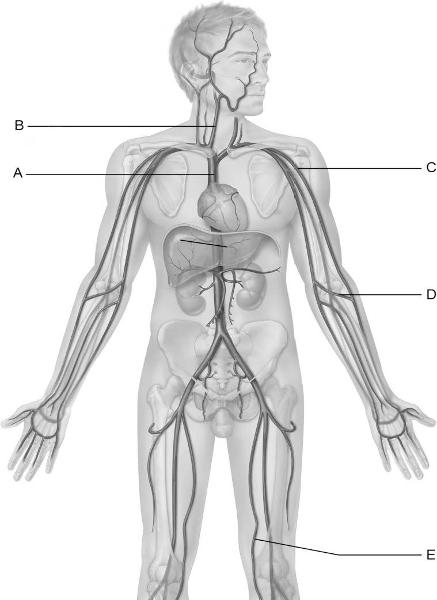
Identify the letter that indicates the cephalic vein.
A)
A
B) B
C) C
D) D
E) E
C
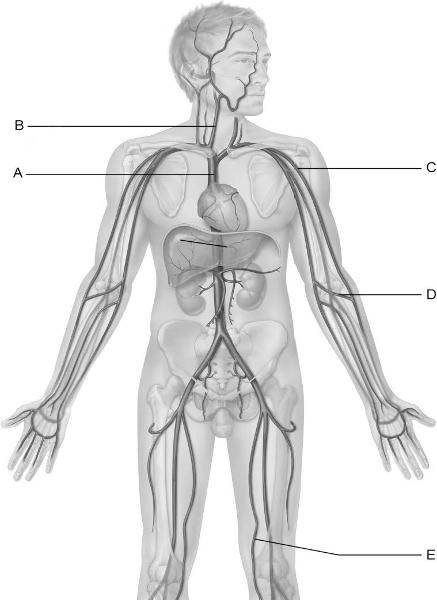
Identify the letter that indicates the internal jugular vein.
A)
A
B) B
C) C
D) D
E) E
B
Layer of blood vessels innervated by sympathetic vasomotor
fibers.
A) tunica intima
B) subendothelial layer
C)
tunica media
D) tunica externa
E) vasa vasorum
C
Capillaries consist of only this layer.
A) tunica intima
B)
subendothelial layer
C) tunica media
D) tunica
externa
E) vasa vasorum
A
Structure that regulates blood flow into true capillaries.
A)
metarteriole
B) thoroughfare channel
C) precapillary
sphincter
D) sinusoids
E) fenestrations
C
Wide leaky capillaries found in bone marrow and spleen.
A)
sinusoids
B) fenestrated capillaries
C) continuous
capillaries
D) metarterioles
E) none of the above
A
A "coming together" of alternate pathways of blood
vessels.
A) thoroughfare channel
B) vasa vasorum
C)
metarterioles
D) vascular anastomosis
E) converging veins
D
Precapillary sphincters allow blood to leave this structure and enter
true capillaries.
A) sinusoids
B) fenestrated
capillaries
C) continuous capillaries
D)
metarterioles
E) none of the above
D
Collective name for the structures that drain the cranium.
A)
vascular anastomosis
B) dural sinuses
C) internal jugular
vein
D) cavernous sinuses
E) inferior vena cava
B
Present in most capillaries, these structures are absent in those of
the blood-brain barrier.
A) tight junctions
B) endothelial
cells
C) basement membrane
D) intercellular clefts
E) pericytes
D
Vessels of the small intestines, renal glomerulus, and synovial
membranes that allow passage
of fluid and solutes through
"windows" in the endothelium.
A) sinusoids
B)
fenestrated capillaries
C) continuous capillaries
D)
metarterioles
E) none of the above
B
Microvasculature that provides nourishment to the outer walls of the
aorta.
A) tunica intima
B) subendothelial layer
C)
tunica media
D) tunica externa
E) vasa vasorum
E
Which layer of blood vessels contains smooth muscle tissue?
A)
tunica intima
B) tunica media
C) tunica externa
D)
tunica adventitia
B
Most small molecules pass through a capillary wall through which
route?
A) via direct diffusion through the endothelium
B)
via pinocytotic vesicles
C) through intercellular clefts
D)
through tight junctions
C
Functionally, there are no valves in arteries (as opposed to in
veins) because
A) valves direct blood only toward the heart and
arterial blood passes away from the heart.
B) valves would tear
apart from the high arterial pressure.
C) arteries get more
atherosclerosis, so valves would cause lethal blood clotting.
D)
the blood pressure in arteries is high enough that there is no
backflow of blood.
D
29) Blood pressure is highest in the
A) elastic
arteries.
B) arterioles.
C) veins.
D) capillaries.
A
The hepatic portal system has two distinct capillary beds separated
by a portal vein. What are
the functions of these two capillary
beds?
A) The first picks up digested nutrients, and the second
delivers these nutrients to liver cells.
B) The first nourishes
the digestive tube, and the second picks up nutrients from the
digestive
tube.
C) The first provides oxygen to the liver,
and the second picks up nutrients from the liver.
D) The first
picks up toxins from the liver, and the second delivers them to the
digestive tube for
detoxification.
A
The pulse of the facial artery is palpated
A) anterior to the
auricle of the ear near the temple.
B) anterior to the masseter
muscle at the inferior margin of the mandible.
C) anterior to the
sternocleidomastoid.
D) in the anterior triangle of the neck.
B
A blood vessel that ranges from 0.3 mm to about 1 cm in diameter and
has a large tunica
media relative to the size of the lumen
is
A) an elastic artery.
B) a muscular artery.
C) an
arteriole.
D) a capillary.
B
In a capillary bed, relaxation of the precapillary sphincters causes
more blood to flow
A) into the thoroughfare channels.
B)
into the arterioles.
C) through the true capillaries.
D)
through the metarterioles.
C
The dorsalis pedis artery is located by
A) finding the head of
the fibula and palpating inferior to its neck.
B) palpating
between the first and second metatarsal.
C) placing the fingers
behind the knee.
D) placing a finger behind the medial malleolus.
B
What artery enters the skull through the foramen spinosum and
supplies the inner surface of
the parietal bone, dura mater, and
parts of the temporal bone?
A) internal carotid artery
B)
middle cerebral artery
C) middle meningeal artery
D) basilar artery
C
Two large (wide) arteries that have relatively superficial locations
and are often wounded are
the
A) aorta and the popliteal
artery.
B) right and left coronary arteries.
C) brachial
artery and posterior intercostal arteries.
D) common carotid
artery and the femoral artery (in the superior thigh).
D
If a physician cannot feel a pulse in the popliteal fossa, the
________ artery is most likely
narrowed by
atherosclerosis.
A) dorsalis pedis
B) femoral
C)
fibular
D) greater saphenous
B
Of the following, the only unpaired dural sinus is the
A)
cavernous sinus.
B) superior sagittal sinus.
C) transverse
sinus.
D) carotid sinus.
B
Which vessel is missing in the following statement? "Tracing
venous blood from the inferior
left side of the posterior
abdominal wall to the heart, we find that blood enters the
posterior
intercostal veins, the hemiazygos vein, the superior
vena cava, and the right atrium."
A) the azygos vein
B)
the hepatic portal vein
C) the inferior vena cava
D) the
right brachiocephalic vein
A
The foramen ovale in the heart normally closes
A) in the 2-month
fetus.
B) in the 7-month fetus.
C) shortly after
birth.
D) never.
C
Which vessel is most commonly used to bypass a damaged coronary
artery in coronary
bypass surgery?
A) azygos vein
B)
great saphenous vein
C) femoral artery
D) internal carotid artery
B
What vessel in the fetus connects the pulmonary trunk to the aortic
arch so that most of the
blood bypasses the immature
lungs?
A) ductus venosus
B) foramen ovale
C) ductus
arteriosus
D) umbilical vein
C
Which of the following statements about arteries is false?
A)
Arterial walls are thicker than venous walls.
B) Arteries have a
smaller lumen than veins of similar size.
C) Arteries carry
oxygenated blood to the heart.
D) Arteries have more elastin than veins.
C
Which branch (or branches) of the abdominal aorta supplies the
stomach?
A) celiac trunk
B) superior mesenteric
artery
C) inferior phrenic arteries
D) suprarenal arteries
A
The cerebral arterial circle forms a loop around which
structures?
A) the great vessels at the base of the heart
B)
the internal and external carotid arteries
C) the
cerebellum
D) the pituitary gland and the optic chiasma
D
The abdominal aorta divides at its distal end into which
arteries?
A) the femoral arteries
B) the internal iliac
arteries
C) the external iliac arteries
D) the common iliac arteries
D
Which of the following is most likely to become a varicose
vein?
A) the femoral vein
B) the saphenous vein
C) the
popliteal vein
D) the fibular (peroneal) vein
B
Fenestrated capillaries
A) are located in the central nervous
system.
B) have pores in their walls.
C) permit the movement
of very few molecules.
D) occur in most of the organs of the body.
B
The correct proximal to distal sequence of the three vessels
branching from the aortic arch is
A) brachiocephalic, left common
carotid, left subclavian.
B) brachiocephalic, left subclavian,
left common carotid.
C) left common carotid, left subclavian,
brachiocephalic.
D) left subclavian, left common carotid, brachiocephalic.
A
What prevents the backflow of blood in veins?
A) valves
B)
the narrowed lumen
C) thick smooth muscle and elastic
layers
D) increased blood pressure
A
The largest molecules that pass through the walls of typical
capillaries are thought to use
which route?
A) direct
diffusion through the endothelium
B) pinocytotic vesicles
C)
intercellular clefts
D) tight junctions
B
The internal carotid artery branches to form the
A) anterior
cerebral, middle cerebral, and ophthalmic arteries.
B) facial,
maxillary, and superficial temporal arteries.
C) middle meningeal
and middle cerebral arteries.
D) posterior cerebral and posterior
communicating arteries.
A
Most systemic venous blood is both oxygen-poor and nutrient-poor.
However, systemic
venous blood that is not oxygen-poor and is
nutrient-rich occurs in
A) the renal vein.
B) superficial
veins of the limbs.
C) the hepatic portal vein.
D) the
pulmonary veins.
C
The ________ delivers arterial blood to the rotator cuff muscles and
thyroid gland.
A) axillary artery
B) costocervical
trunk
C) thyrocervical trunk
D) vertebral artery
C
The diameter of a typical capillary is similar to that of
A) a
venule.
B) a sinusoid.
C) an erythrocyte.
D) a fat cell.
C
Which of the following statements about arterioles is false?
A)
They regulate the flow of blood to capillary beds through contraction
and relaxation of the
tunica media.
B) They redirect blood
flow in a sympathetic response to skeletal muscle.
C) They can
lead into metarterioles.
D) They have the largest content of
smooth muscle in their tunica media.
D
Systemic venous blood that is oxygen-poor but contains the lowest
concentration of
nitrogenous wastes occurs in the
A) renal
veins.
B) hepatic portal vein.
C) pulmonary veins.
D)
umbilical veins of the fetus.
A
A preferred site to insert intravenous catheters is into the
A)
brachial vein.
B) dorsal venous network of the hand.
C)
great saphenous vein.
D) superficial palmar venous arch of the hand.
B
Which artery arises from the inferior part of the abdominal aorta and
supplies the distal half
of the large intestine?
A) gonadal
artery
B) median sacral artery
C) superior phrenic
artery
D) inferior mesenteric artery
D
The main arteries of the sole of the foot—the medial and lateral
plantar arteries—arise
behind the ankle from which
artery?
A) posterior tibial
B) fibular
C)
saphenous
D) dorsalis pedis
A
A dural sinus that contains a major artery and some cranial nerves
within it is the
A) superior sagittal.
B) inferior
sagittal.
C) cavernous.
D) transverse.
C
Which vessel is missing from the following statement? "Tracing
blood that drains from the
large intestine, we find that blood
drains from the distal colon is collected in the
inferior
mesenteric vein, merges with the splenic vein then
directed to the hepatic portal vein, the liver
sinusoids, and the
inferior vena cava."
A) celiac vein
B) umbilical
vein
C) hepatic vein
D) azygos vein
C
In the adult, the hepatic portal system carries nutrients absorbed
from the digestive tract to
the liver. In the fetus, nutrients
are absorbed at the placenta, and the vessel that carries
these
nutrients to the liver is the
A) hepatic portal
vein.
B) placental vein.
C) umbilical vein.
D) internal
iliac vein.
C
The right suprarenal and gonadal veins drain into the inferior vena
cava, whereas the left
suprarenal and gonadal veins drain into
the
A) superior vena cava.
B) other side of the inferior
vena cava.
C) hepatic portal system.
D) left renal vein.
D
By definition, veins are
A) vessels that carry blood toward the
heart.
B) vessels that always carry nutrient-poor blood.
C)
the only vessels that lead from capillaries.
D) vessels that
carry oxygen-poor blood.
A
Which body tissues lack capillaries?
A) the myocardium and
epicardium of the heart
B) tendons and ligaments
C) the lens
and the cornea
D) bones
C
Which arteries connect the basilar artery and the internal carotid
artery forming the posterior
aspect of the cerebral arterial
circle?
A) genicular arteries that encircle the knee
B)
posterior communicating arteries
C) ulnar artery that encircles
the elbow joint
D) anterior communicating arteries
B
The extensor muscles of the forearm are supplied by which
artery?
A) radial
B) posterior interosseous
C)
ulnar
D) deep palmar arch
B
The lumbar veins drain the inferior posterior abdominal wall and
direct oxygen-poor blood
into the
A) superior vena
cava.
B) internal iliac vein.
C) external iliac
vein.
D) inferior vena cava.
D
Which of the following is not a branch of the celiac trunk?
A)
left gastric artery
B) common hepatic artery
C) sigmoidal
artery
D) splenic artery
C
The right gonadal vein drains into the
A) inferior vena
cava.
B) internal iliac vein.
C) lumbar vein.
D) renal vein.
A
The circulatory route that runs from the digestive tract to the liver
is called
A) coronary circulation.
B) pulmonary
circulation.
C) hepatic portal circulation.
D) cerebral circulation.
C
Blood passing through the fetal ductus arteriosus bypasses
the
A) lungs, left atrium, and ventricle.
B) pulmonary trunk
and lungs.
C) right atrium and ventricle.
D) right
ventricle, pulmonary trunk, and lungs.
A
All types of blood vessels contain a tunica intima.
A) True
B) False
A
All arteries carry oxygen-rich blood, whereas veins carry oxygen-poor blood.
A) True
B) False
B
Systemic blood pressure is regulated by adjusting the diameter of arterioles.
A) True
B) False
A
In metabolically active tissues, blood is present in metarterioles,
and precapillary sphincters
are constricted.
A) True
B) False
B
Postcapillary venules function much like true capillaries.
A) True
B) False
A
The pulse of the posterior tibial artery is palpated behind the knee.
A) True
B) False
B
Veins have less elastin in their walls than do arteries.
A) True
B) False
A
Arterioles and venules have a vasa vasorum to provide nutrients to
their outer walls, whereas
the inner walls receive nutrients from
blood in the lumen.
A) True
B) False
B
The middle and posterior cerebral arteries are connected by the
posterior communicating
arteries.
A) True
B) False
A
The internal iliac arteries supply blood both to the pelvic organs and to the lower limbs.
A) True
B) False
A
The inferior vena cava ascends on the left side of the vertebral
bodies and to the left of the
abdominal aorta.
A) True
B) False
B
Muscular arteries regulate blood flow to organs and groups of organs.
A) True
B) False
A
The elastic arteries are the largest arteries near the heart.
A) True
B) False
A
The saphenous vein is not paired with an artery with the same name.
A) True
B) False
A
Paired fetal umbilical veins carry blood from the fetus to the
placenta, whereas the unpaired
umbilical artery returns blood
from the placenta to the fetus.
A) True
B) False
B